| |
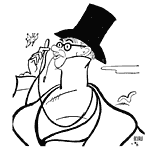 The New Yorker and the Single-panel Gag Cartoon The New Yorker and the Single-panel Gag Cartoon
Harold Ross, Peter Arno and Rea Irvin
We
can ponder paintings on cave walls and the Bayeux Tapestry and Mexican
codices all week long, but I'll still say that the essential characteristic
of "comics"—the thing that distinguishes it from other kinds
of pictorial narratives (like cave paintings and the Bayeux Tapestry)—is
the incorporation of verbal content. I even go so far as to say that
in the best examples of the art form, words and pictures blend to achieve
a meaning that neither conveys alone without the other. To Scott McCloud,
"sequence" is at the heart of the functioning of comics; to
me, "blending" verbal and visual content is. And the history
of cartooning—of "comics"—seems to me more supportive of my
contention than of his. Moreover, the evolution of the modern so-called
"gag cartoon" (the humorously intended single-panel drawing
with verbal caption beneath) contains within itself the most vivid demonstration
of the reason for that evolution—namely, the emergence of a superior
humorous effect that is realized only with the economy of expression
achieved by verbal-visual interdependence.
I realize that the gag cartoons fall
outside most definitions of comics. But not mine. In my view, comics
consist of pictorial narratives or expositions in which words (often
lettered into the picture area within speech balloons) usually contribute
to the meaning of the pictures and vice versa. A pictorial narrative
uses a sequence of juxtaposed pictures (i.e., a "strip" of
pictures); pictorial exposition may do the same—or may not (as in single-panel
cartoons—
political
cartoons as well as gag cartoons). My definition is not a leak-proof
formulation. But leak-proof or not, this proffer of a definition sets
some boundaries within which we can find most of the artistic endeavors
we call "comics." Even pantomime, or "wordless,"
cartoon strips—which, guided by this definition, we can see are pictorial
narratives that dispense with the "usual" practice of using
words as well as pictures. But that doesn't make the usual practice
any the less usual. Pantomime cartoon strips are exceptional rather
than usual. Usually, the interdependence of words and pictures is vital
(if not essential) to comics, and the vitality of that yoking is readily
apparent (and handily exhibited) in an examination of the history of
the gag cartoon.
In tracing the history of cartooning,
we don't need to go very far back. Homo sapiens doubtless began scrawling
goofy pictures on cave walls before the dawn of history as we know it,
but we need go no further into the dim recesses of the past than the
emergence of the modern use of the term "cartoon." Gag cartooning
probably began in the 18th century with the publishing of broadsides,
single-sheet publications displaying caricatures or vignettes of moral
impor—the work of such irrepressible British wags as William Hogarth
(1697-1764), James Gillray (1756-1815), and Thomas Rowlandson (1756-1827)
and the Spaniard Francisco Goya (1746-1828), to mention a few. This
custom was perpetuated and refined in weekly and monthly humor magazines
in the 19th century. In France, gadfly caricaturist Charles Philipon (1806-1862) started a thoroughly
political weekly, La Caricature,
in 1830, adding the more literary
Le Charivari to his productions two years later and employing the
work of such satirical artists as Honore Daumier (1808-1879) and Jean
Grandeville (1803-1847). In England, Punch (subtitled "The
London Charivari") was launched in 1841, and "cartoon"
was first employed in the modern sense in reference to this magazine.
As we all know, "cartoon"
comes from the Italian "cartone," meaning "card."
Italian tapestry designers and fresco painters and the like drew their
designs on sheets of cardboard at full scale before transferring those
designs to the cloth or walls they were intended for. These designs
were called by the name of the material upon which they were draw—"cartones,"
or "cartoons." Later, the word "cartoon" was applied
to any preliminary study for a final work, and it is here that we meet
the modern usage of the term.
The modern usage of "cartoon"
began in London in the 1840s. The Houses of Parliament had been all
but destroyed in a fire in 1834. The building that took the place of
the gutted relic was called the New Palace of Westminster and was built
over the next decade. By the mid-1840s, it had been determined that
the New Palace would contain various murals on patriotic themes, and
a competitive exhibition was held to display the cartoons (in the ancient
sense) submitted as candidates for these decorations. Punch, then only a couple years old, entered the competition on its
own, publishing in its pages a series of five satirical drawings about
government and calling them "Mr. Punch's cartoons." The first
of these appeared in the weekly issue dated July 15, 1843, and was greeted (we may as well suppose) with howls
of joyous appreciation.
Identified in the magazine as "Cartoon
No. 1," the drawing by John Leech depicts a motley collection of
London's down-trodden and threadbare street folk who are viewing
the exhibition of the cartoons submitted to the Parliamentary competition,
an array of portraits of regal personages. 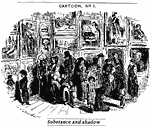 Entitled
"Substance and Shadow," the irony gains additional impact
from a caption: "The Poor Ask for Bread, and the Philanthropy of
the State Accords—an Exhibition." Even in this, the first modern
example of "cartoon," the words give meaning to the picture
and vice versa as in my modern visual-verbal equation. Entitled
"Substance and Shadow," the irony gains additional impact
from a caption: "The Poor Ask for Bread, and the Philanthropy of
the State Accords—an Exhibition." Even in this, the first modern
example of "cartoon," the words give meaning to the picture
and vice versa as in my modern visual-verbal equation.
At first, Punch continued to call its humorous drawings "pencilings."
Eventually, it applied the term "cartoon" to any full-page
politically satirical drawing (and most "cartoons"—but not
all—in these earliest years were what we would term "political
cartoons" rather than simply humorous) . But to the man in the
street, any funny drawing in the magazine after the summer of 1843 was
termed one of "Punch's cartoons," and by this route, the word
came into use for any comical drawing, of which, as time went on, there
were more and more of the a-political kind. By the time Americans launched
their imitations of Punch in the 1800s, "cartoon"
was well on its way to being established in the modern sense. And so
was "cartoonist."
Punch
inspired many imitators on this side of the Atlantic—Wild Oats, Phunny Phellow, and
others, most of which failed after a few issues or months. Among those
that lasted were the weekly humor magazines Puck,
Judge, and Life, all introduced
in the 1880s (and all sometimes called "comic weeklies").
By this time, magazine cartooning had
branched into the two categories to which I've already allude—the political
and the purely comic (the latter, eventually termed "gag cartoons"
by cartoonists). Typically, the political cartoons were given the greater
play: they appeared on the covers (front and back) and sprawled across
the double-truck of the center spread. (To examine at any length here
the development of the political cartoon would take us pretty far out
on that limb, so let me lop off that bough now before it breaks and
leaves us stranded hopelessly beyond the reach of this essay.) Other
cartoons often honed a political axe or two, but they, and the strictly
humorous cartoons, were spotted throughout the magazines amid paragraphs
of light-hearted prose and verse. Some of the drawings were half-page
in size; others, quite small. Virtually all of these efforts were captioned
with several lines of text in type. Usually the text was itself comedic
and self-contained: the reader didn't need the picture to understand
the joke.
Until the 1920s, magazine gag cartoons
were mostly illustrations of this sort. Lee Lorenz, long-time cartoon
editor at The New Yorker, writing
in his ground-breaking tome The
Art of the New Yorker, calls the earliest of these specimens "illustrated
anecdotes" because the captions were sometimes two or three paragraphs
in length; the drawings did no more than illustrate the situation to
which the text applied. The text was gradually refined: first, it was
transformed into a sort of conversation among the several persons depicted
in the drawing; eventually, the dialogue was reduced to a verbal exchange
between two persons. These are the "multiple-speaker captioned
cartoons" (the fondly recalled "he-she" cartoons in which
He says something; then She responds with something funny—or vice versa).
Here's a sample:
Wife: How many cigars a day are you smoking now?
Husband: Oh, just enough to show the doctor his advice was wrong.
In
cartoons like these (of which there were millions from about 1880 until
1920), the pictures contributed almost nothing to the joke. We don't
need the picture in order to see the humor in the dialogue. Cartoonists
of the day called these specimens "illustrated jokes," betraying
their belief that the humor was contained in the prose not the pictures.
In some cartoons, however, the pictures provide the setting that makes
sense of the caption—for instance:
Uncle: Poor girls, so few get their wages.
Flapper: So few get their sin, darn it.
They
are walking along a street in front of a church on the door of which
is a sign advertising the day's sermon: The Wages of Sin. 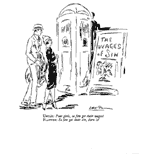 Without
the scene-setting picture, the cartoon isn't very funny. (This cartoon,
incidentally, was published in the first issue of The New Yorker.) But most cartoons of the
earliest vintage are essentially verbal witticisms that are funny without
their accompanying illustrations. Without
the scene-setting picture, the cartoon isn't very funny. (This cartoon,
incidentally, was published in the first issue of The New Yorker.) But most cartoons of the
earliest vintage are essentially verbal witticisms that are funny without
their accompanying illustrations.
When, at the close of the 19th century,
the great metropolitan daily newspapers (particularly in New York) sought
to increase circulation by publishing extravagant Sunday supplements
that included imitations of the comic weeklies (often dubbed, now, "the
comics"), cartooning expanded in two directions: in newspapers,
cartoonists started creating short narratives by arraying their pictures
in storytelling sequences ("comic strips"); in magazines,
cartoonists continued pretty much as before, but in striving for ways
of creating comedy, they also exploited the capacity of the medium for
visual puns. 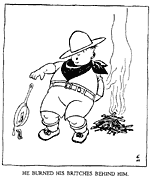 Visual
punning emphasized the importance of the pictures to the comedy in single-panel
cartoons. Perhaps from this development—sporadic and occasional as it
was amid the usual array of "illustrated anecdotes"—cartoonists
began to realize that the comedic impact of their work would be much
enhanced if the meaning or significance of the words under their pictures
could be understood only by comprehending the role of the picture. And
vice versa. Visual
punning emphasized the importance of the pictures to the comedy in single-panel
cartoons. Perhaps from this development—sporadic and occasional as it
was amid the usual array of "illustrated anecdotes"—cartoonists
began to realize that the comedic impact of their work would be much
enhanced if the meaning or significance of the words under their pictures
could be understood only by comprehending the role of the picture. And
vice versa.
Whatever the cause, by the 1920s, a
new style of gag cartoon was evolving. Cartoonists had discovered that
all cartoons—not just visual puns—were funnier if the humor arose from
joining picture to words in such a way that the one "explained"
the other. In this form, gag cartooning achieves its apotheosis when
neither the picture nor the words have humorous meaning alone. The picture
sidles into a reader's consciousness as a kind of visual puzzle, meaningless
until reading the caption "explains" it. The picture likewise
"explains" the caption. Either way, as comprehension dawns—in
the flash of an instant—the humor is revealed, and the revelation, coming,
as it does, suddenly, gives comic impact to the combined "meaning"
of the visual-verbal blend. In effect, the joke's impact derives from
the "surprise" that is sprung upon the reader when he or she
understands the full import of the picture or the caption. The hilarity
is further enhanced if only one of the characters in the picture is
speaking: this maneuver effectively heightens the importance of blending
picture to words to achieve an economy in expression that increases
the "surprise" inherent in the blend—and, hence, the humor
of the joke. And so emerged the "single-speaker captioned cartoon,"
the modern gag cartoon.
Because the modern gag cartoon is more
economical in the deployment of verbal and visual resources, it is more
focussed and therefore has greater impact. Employing the same economy,
cartoonists achieve similar impact in comic strips, too, and the best
funnybook artists also strive to yoke pictures and words in tandem for
narrative sense. But the blend is more demonstrably evident in the relatively
simple gag cartoon.
A classic cartoon of this breed is
one by Peter Arno for The New
Yorker. 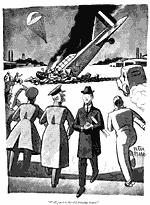 The
picture shows several military personnel aghast at viewing, in the distance,
the crash of an airplane, obviously one of theirs. A parachute hovering
over the crashing plane reassures us that no lives have been lost in
the tragedy. Emerging from the crowd and coming toward us is a mousy-looking
man who is grinning and rubbing his hands and saying, "Well, back
to the old drawing board." The picture makes absolutely no comedic
sense without the caption; and the caption is not at all humorous without
the picture. It may be debated whether there is any humor in the grim
situation depicted, but the expression on the face of the mousy man
shifts our orientation from a possible tragedy to the comedy that always
lurks at the edge of ordinary human self-absorption. The
picture shows several military personnel aghast at viewing, in the distance,
the crash of an airplane, obviously one of theirs. A parachute hovering
over the crashing plane reassures us that no lives have been lost in
the tragedy. Emerging from the crowd and coming toward us is a mousy-looking
man who is grinning and rubbing his hands and saying, "Well, back
to the old drawing board." The picture makes absolutely no comedic
sense without the caption; and the caption is not at all humorous without
the picture. It may be debated whether there is any humor in the grim
situation depicted, but the expression on the face of the mousy man
shifts our orientation from a possible tragedy to the comedy that always
lurks at the edge of ordinary human self-absorption.
My choice, here, of a New Yorker cartoon is not altogether casual.
In his New Yorker article
celebrating the magazine's 70th anniversary, Charles McGrath says flatly
that Harold Ross invented the modern single-speaker gag cartoon. Well,
yes and no.
Without a doubt, no history of gag
cartooning could overlook Harold Ross, the world's most unlikely candidate
for editor-founder of the nation's most sophisticated magazine of humor
and urbanity. A frontier kid with only a tenth-grade education, he was
born November 6, 1892, in Aspen, Colorado, then a mining camp. When he left town as a teenager,
he became a slovenly tramp newspaperman who spend his years before World
War I roving from one newspaper to another, a common type in those years.
During the war, he worked on Stars
and Stripes, the armed forces newspaper, and he fell in with a convivial
crew, and after the War, they all landed in New York, where they encouraged Ross to launch, after a false
start or two, The New Yorker.
The magazine struggled in fiscal red ink for years, but Ross never wavered
in pursuit of his vision. He couldn't articulate it, but he knew what
he wanted. Slowly, he assembled writers (E.B. White, James Thurber,
Janet Flanner, Katharine Angell White, Frank Sullivan) and cartoonists
(Arno, Rea Irvin, Helen Hokinson, Charles Addams, George Price) who
gave the publication its distinctive flavor.
But Ross remained throughout his life
the same, a contradictory sort—a rowdy, gangly, mussed-up hick-looking
wight with electric hair (a sort of brush cut standing on its ends),
a gap-toothed grin, a droll sense of humor, and a profane vocabulary.
In both his uncouth eccentricity and sheer doggedness, Ross was without
equal in American journalism. And his magazine became a beacon to cartoonists,
beckoning to modern times. It became a showcase for gag cartoonists,
but the single-speaker captioned cartoon wasn't invented there, whatever
the oft-uttered claims of cartoon mythology.
The single-speaker gag 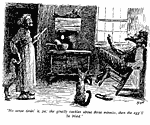 cartoon
was in fairly widespread use in the old humor magazines Life and Judge(not to mention
that child of the 1920s, College
Humor) long before Ross launched The
New Yorker in 1925. Cartoonists still did mostly multiple-speaker
cartoons, but single-speaker cartoons were not hard to find. cartoon
was in fairly widespread use in the old humor magazines Life and Judge(not to mention
that child of the 1920s, College
Humor) long before Ross launched The
New Yorker in 1925. Cartoonists still did mostly multiple-speaker
cartoons, but single-speaker cartoons were not hard to find.
Peter Arno was often credited with
inventing the single-speaker cartoon at
The New Yorker, but he specifically denied it (in his introduction
to Peter Arno's Ladies and Gentlemen). "I
like to think that I did," Arno wrote, "and I have been given credit for it; but nothing so basically
simple could be 'invented.' It must be as old as Confucius, or older.
It was just lying there all the time, waiting to be picked up. I gravitated
toward it naturally, and was one of the first to use it consistently,
so that it became more or less a trade-mark. . . . I suppose it appealed
to me because my English grandfather, who was the light of my boyhood
years, had taught me that brevity was the soul of wit . . . . As with
a smoking-room story, the shortest caption, if it hits with a wallop,
brings the loudest guffaw; the kind that warms my heart."
Clearly, the notion of the single-speaker
cartoon was not invented by one person. Not Peter Arno. Not Harold Ross.
But Ross gets the credit because his
magazine lasted; the others that used cartoons did not. If Life and Judge had lasted
(both, for all practical purposes, expired in the 1930s), they would
doubtless have used the single-speaker cartoon as consistently as The New Yorker did. And then not any one of them would be able to
claim the invention of the genre. But Ross's magazine outlasted its
rivals. And because the gag cartoon had evolved into a single-speaker
captioned cartoon in which the words and the pictures (in the best of
them) were "interdependent" (to use Arno's phrase) and because
The New Yorker used lots of gag cartoons,
Ross and his cartoonists are credited with having invented the form.
Doubtless Ross's eccentric literalism
contributed to the evolution of the modern gag cartoon. He examined
cartoon submissions as if they were drawn by artists who wanted to put
something over on him. And he was dedicated to preventing that from
happening. Despite the profanity with which he liberally seasoned his
utterances, Ross was relentlessly puritanical about whatever found its
way into print. ("He's real uninhibited that way," a female
contributor from the Southern states is said to have remarked, admiringly.)
No swear words. And nothing even vaguely smutty. According to legend,
he even barred such indecorous words as "armpit" and "pratfall."
The only even sexualvulgarity that was ever sneaked into the magazin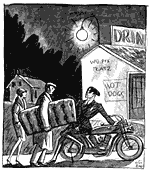 e
was an Arno cartoon in which a young couple was depicted walking along
a country road at night, carrying the back seat of an automobile between
them and saying to the local constable whom they encountered on their
trek, "We want to report a stolen car." Friends maintain that
the cartoon slipped under Ross's searchlight gaze because he simply
didn't understand it. Ross protested vehemently: "I knew what it
was about, all right," he exclaimed. "Why else would I have
run it?" But he added a revealing murmur: "My theory was,
they'd just been sitting on it." e
was an Arno cartoon in which a young couple was depicted walking along
a country road at night, carrying the back seat of an automobile between
them and saying to the local constable whom they encountered on their
trek, "We want to report a stolen car." Friends maintain that
the cartoon slipped under Ross's searchlight gaze because he simply
didn't understand it. Ross protested vehemently: "I knew what it
was about, all right," he exclaimed. "Why else would I have
run it?" But he added a revealing murmur: "My theory was,
they'd just been sitting on it."
One manifestation of the hallucinatory
albeit friendly antagonism between editor and cartoonists was that the
cartoons had to measure up to Ross's standard for verisimilitude. In
his biography of Ross, Genius
In Disguise, Thomas Kunkel writes: "In Ross's cartoon universe,
houses were supposed to face the road; doors theoretically had to be
able to swing unobstructed [by furniture or some architectural whimsy
of the cartoonist]; lamps were expected to have cords (though some of
Ross's favorite artists had dispensation to conceal them beneath a rug)."
Ross insisted on such niggling details.
He also insisted that he, as a reader, should be able to tell at a glance
which of the persons in the drawing was speaking. Here, he was rebelling
against the old multiple-speaker illustration: depicting several speakers,
the old time cartoonists didn't have to worry about which of the persons
had his or her mouth open. Either they all did; or none of them did.
But when there is only a single speaker, the reader must know which
of the persons in the picture is that speaker.
Ross's insistence on this seemingly
trivial matter doubtless helped to focus his cartoonists' efforts in
the direction of the single-speaker cartoon because only in such cartoons
did you need to discern which of the people depicted was speaking. And
so by such indirections might Ross be said to have nudged the magazine
cartoon into its modern manifestation. But Ross also realized that the
kind of cartoon he wanted in The
New Yorker was different from the "illustrated joke" of
the previous generation of humor magazines. He had difficulty, however,
in translating his notions into very precise guidance. In the summer
of 1925, an advisory letter to contributors called for cartoons that
were "illustrative of ideas" rather than of situations. In
her book Defining New Yorker Humor,
Judith Yaross Lee argues that this vague notion soon evolved into the
"idea drawing," the "key discovery" of which was
"the ironic relations between image and text"—in other words,
a cartoon in which the words and pictures blend to achieve a meaning
neither is capable of alone without the other.
By 1932, Ross had a pretty firm grasp
of what he was after in cartoons. Writing to cartoonist Alice Harvey
(no relation) on July 27, he discussed his convictions: "Before The New Yorker came into existence . .
. the editors [of humor magazines] bought jokes, or gags, or whatever
you want to call them, for five dollars or ten dollars, [and] mailed
these out to artists. . . . The result was completely wooden art. The
artists' attitude toward a joke was exactly that of a short story illustrator's
attitude toward a short story. . . . Now, this practice led to all humorous
drawings being "illustrations." It also resulted in their
being wooden, run-of-the-mill products. The artists never thought for
themselves and never learned to think. They weren't humorous artists;
they were dull-witted illustrators. A humorous artist is a creative
person, an illustrator isn't. At least they're not creative so far as
the idea is concerned, and in humor, the idea is the thing. . . . Unless
an artist takes ahold of an idea and does more than "illustrate"
it, he's (she's) not going to make a humorous drawing. . . .
"I judge from your letter that
you apparently don't realize that you are one of the three or four pathfinders
in what is called the new school of American humor [in cartooning]. Your stuff in
Life before The New Yorker
started might well be considered the first notes of this new humor.
I remember seeing it and being encouraged by it when I was thinking
of starting The New Yorker.
But Alice Harvey didn't invent the
single-speaker caption cartoon any more than Ross did. The canny editor
was doing what he often did to cajole performance from his contributors:
he was flattering her into submission. As I've said, other cartoonists
were doing the same thing earlier than Harvey's work appeared. And they
were producing such cartoons long before
The New Yorker debuted. But Ross's magazine established
the form as the most effective for the single panel cartoon. Moreover,
the establishing of the form was not done by any single individual.
Ross was the editor and set various mechanisms in motion that eventually
refined the gag cartoon, but one of those mechanisms was the group effort
that created each issue of the magazine.
In the same letter to Alice Harvey,
Ross indicates a practice that the magazine had been following for some
years—namely, shopping good cartoon ideas to those cartoonists whose
styles best suited the ideas. In fact, many if not most of the cartoons
in The New Yorker were manufactured by the
cartoonists to fit captions supplied by others, most often staff writers—"especially
at the beginning," Kunkel notes. When in 1934 Gluyas Williams objected
to using the ideas of others, Ross wrote him in exasperation: "This
magazine is run on ideas. . . . My God, a very large percentage of the
contents of The New Yorker,
drawings and text, are based on the ideas originating with the staff
and suggested to writers. . . . We
don't ever try to cram an idea down an artist's throat. We always send
it as a suggestion made on a take it or leave it basis. I'm flatly against
our buying ideas as the old humorous magazines used to do and then sending
them out to an artist to do at some much per picture. That is ruinous
to humorous art, I think, or to anything creative. Our attitude, honestly
observed, I think, in practice, is that we submit an idea to an artist
and that if he sees fit to use it as a suggestion for a picture into
which he is going to put something of his own, he will proceed to draw
it; otherwise not. . . . The one thing that has made The
New Yorker successful is that it is a collaborative effort, switching
ideas back and forth to find the man best adapted to doing them."
Arno says he thought up his own gags
in the early years. "I had to," he wrote. "I was developing
a style and a new kind of format, and there was no way anyone else could
do it for me. But as time went on and a distinct pattern for my work
was set, it became easier for others to make contributions."
The same was doubtless true with other
cartoonists whose style of humor was distinctive. Even, apparently,
as individual a talent as George Price, who, I was startled to learn,
produced only one of his hundreds of highly idiosyncratic New Yorker cartoons from his own idea according to Lee Lorenz. In
his account of life at The New
Yorker, Thurber says some cartoonists thought up their own ideas;
others used the ideas supplied by staff writers. "In the early
years," Thurber wrote, "Andy [E.B.] White and I sent [in]
scores of captions and ideas, some of them for full-page drawings, others
for double-page panels for Gluyas Williams and Rea Irvin. If a caption
didn't suit Ross—and he was as finicky about some of them as a woman
trying on Easter bonnets—it was given to White to 'tinker.' [Wolcott]
Gibbs and I did tinkering, too, but White was the chief tinkerer."
Kunkel tells the story of an idea generating
session between Arno and one-time art editor Albert Hubbell. Hubbell
went to Arno's Park Avenue apartment one afternoon where he found Arno,
"a creature of the night," still in a silk dressing gown.
Arno fixed himself a hamburger and sat down to hear Hubbell's ideas.
"One that Hubbell liked and pitched
hard involved a billiard table," Kunkel writes. "But in no
time, Arno was frowning. It turned out that Ross paid him a substantial
bonus for full-page cartoons, which presupposed vertical concepts, so
a billiard table was altogether too lateral to even consider. 'Wait
a minute, Hubb, wait a minute,' Arno said, '—let's go for those pages.'"
In his history of cartooning at the
magazine, Lorenz edges up to the question of the invention of the single-speaker
gag cartoon, but, understandably, he cannot identify any single person
as the inventor. He reports that William Steig and George Price among
others told him that they realized that the single-speaker captioned
cartoon as it emerged was a different kind of cartoon. "Just how
it came about seems impossible to establish sixty-five years after the
fact," Lorenz continues. "I suspect it was the result of the
increasing sophistication of the gag writers rather than the cartoonists
themselves." But he also says that "the single-line caption
required a new subtlety on the part of the artist: the less told in
the caption, the more one had to tell in the drawing." And he goes
on to suggest that White may be the most influential of the magazine's
writers in shaping and refining gag cartooning. "Polishing captions"
was one of White's first assignments upon joining the magazine's staff.
Brendan Gill in Here at The New Yorker also discusses White's contribution to the
magazine's cartoons: "It was crucial that these captions be as
succinct and colloquial as possible, and White had a fine ear for the
natural rhythms of American speech. His seemingly effortless tinkerings
brought thousands of drawings back from the brink of rejection."
Elsewhere, in a discussion of Peter
Arno's development as a cartoonist, Lorenz credits Philip Wylie with
creating Arno's gags. (Wylie worked as Ross's assistant for the first
two years of the magazine's life.) And if Arno was generally perceived
to be the cartoonist who perfected the single-speaker captioned cartoon,
then maybe it is Wylie who should get the credit. (Unless Arno was being
entirely truthful when he said he thought up his own gags in the beginning.)
But I think none of these suspects
is solely responsible for the evolution of the modern gag cartoon. I
think, rather, that the cartoonists themselves saw the enhanced comedic
impact of a picture and its caption when the drawing and the words were
inextricably linked in the most economical way possible—with the caption
being the utterance of a single speaker. Cartoonists (almost by definition
in my book) create in visual-verbal terms. Through the first three decades
of this century, they became more and more accustomed to contriving
comedy that arose from the blend of words and pictures. It would be
natural in the normal progression of things for cartoonists to realize
the superiority of the comedy inherent in the economy of single-speaker
cartoons. And I think those who wrote or polished captions saw the same
thing. They all worked to create better cartoons in this new mode. And
Ross with his eccentricities and cloudy comprehension of what he was
looking for elbowed them along in the same direction.
And there is another player whose presence
may have been influential. That is Rea Irvin, the artist who drew the
cover for the first issue of The
New Yorker and designed the magazine's appearance.
Ross believed that the best thing about
the first issue had been Irvin's cover drawing of the bemused boulevardier
inspecting a passing butterfly through his monocle. So he ran the same
cover e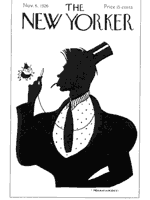 very
year on the magazine's anniversary. And until quite recently, Ross's
successors did the same in honor of the founder (and of Irvin). So Irvin's
supercilious dandy, anachronistically attired in top hat and high collar,
graced the cover once a year for nearly 70 years. (And to celebrate
Ross's birthday in the fall of 1926, the staff assembled a faux issue
of the magazine for which Irvin supplied a silhouetted caricature of
Ross in the famous pose of Eustace Tilley. The spider at which Ross
is sticking out his tongue is Alexander Woollcott, the drama critic
of the New York Times, a former Stars and Stripes staffer with Ross,
a lodger in Ross's house in the West forties, and a persistent pain
in the toukus,) very
year on the magazine's anniversary. And until quite recently, Ross's
successors did the same in honor of the founder (and of Irvin). So Irvin's
supercilious dandy, anachronistically attired in top hat and high collar,
graced the cover once a year for nearly 70 years. (And to celebrate
Ross's birthday in the fall of 1926, the staff assembled a faux issue
of the magazine for which Irvin supplied a silhouetted caricature of
Ross in the famous pose of Eustace Tilley. The spider at which Ross
is sticking out his tongue is Alexander Woollcott, the drama critic
of the New York Times, a former Stars and Stripes staffer with Ross,
a lodger in Ross's house in the West forties, and a persistent pain
in the toukus,)
Rea Irvin was born August 26, 1881, in San Francisco, California, to which his parents had journeyed by covered wagon
in the 1850s. Although Rea attended Hopkins Art Institute in San Francisco, he also entertained the idea of a career in acting,
which he pursued briefly beginning in 1903. He then served in the art
departments of several newspapers, including the Honolulu Advertiser, but eventually, he moved to New York, and by the 1920s he had achieved a good measure of
success as a newspaper and magazine cartoonist, becoming art editor
of the humor magazine Life.
His thespian inclinations remained, however, finding expression in his
theatrical manner of attire and in his demeanor, which radiated the
stage presence of an accomplished actor. He was a familiar figure at
both the Players Club and the Dutch Treat Club.
As Ross refined his plans for The New Yorker in the latter months of
1924, he enlisted Irvin to help with the art chores. Irvin, who had
just been replaced as art editor at Life,
had a flourishing freelance art business, but he agreed to serve as
"art consultant" (Ross eschewed formal titles), stipulating
that he could afford to give only one day a week to the task. Over the
months of preparation, Irvin prepared the layout for the first issue,
drew most of the department headings, and designed the distinctive typeface
for the magazine, modifying a typeface developed by Carl Purington Rollins.
The day that Irvin gave to the magazine
every week was the day he helped Ross select the cartoons for the next
issue. Irvin's taste in art was expansive: he liked classic and modern
art, he was sympathetic to anything new, and he knew good craftsmanship
when he saw it. Moreover, he was articulate about art: he could tell
artists specifically what to do to improve their work and to make it
acceptable to the magazine. When a drawing amused him during the art
conference, he chuckled; and he often gave little lectures on art appreciation.
Irvin's presence and his manner undoubtedly educated Ross in the subtleties
of cartooning, refining the editor's taste and raising his standards.
Thurber, assessing Irvin's contribution
to the magazine, says unequivocally that Irvin "did more to develop
the style and excellence of New
Yorker drawings and covers than anyone else, and was the main and
shining reason that the magazine's comic art in the first two years
was far superior to its humorous prose." Lee agrees that Irvin
was essential: noting his "taste for ironically related images
and text," she goes on to say that "what is often called the
'New Yorker cartoon' deserves
to be called 'the Irvin cartoon.'" Since The New Yorker style of cartoon set the
pace for American magazine cartooning since the early 1930s, Irvin looms
large in the history of the medium as a major influence. In fact, he—not
Ross, not Arno, not White, and not Wylie—might even be said to be the
"father" of modern magazine gag cartooning.
The distinctive "style" of
the New Yorker cartoon arises,
however, from a quality not necessarily inherent in the visual-verbal
blending of the single-speaker captioned cartoon. Lorenz maintains that
the typical New Yorker cartoon is "based more
on character than situation." And that's probably true—if we assume
that the "character" in question is a stereotype, the stereotype
of the sophisticate.
The New Yorker cartoon has always struck me as a rather inert enterprise.
Typically, it depicts two or more people passively seated and talking
laconically. If the people appear to be sophisticated upper-middle or
upper class persons, then they say something faddish or childish or
completely silly. If they appear to be lower class or otherwise weird
(think of Price's people), then what they are saying is often trite
or commonplace or incongruously elitist.
The comedy in either situation arises
from the contrast between the appearance and the utterance. The effect,
however, is to ridicule the pseudo sophisticate—the Old Society snob
and the nuevo riche poseur. Ross consciously aimed
at readers who were young and upscale and who might reasonably be expected
to want the better things in life—but who could, as Lee notes, "laugh
at themselves." "Pictures," she continues, "established
The New Yorker's aura of eliteness
through the elegant figures populating them. Captions typically undercut
the characters' superiority, and New Yorker humor critiqued all ages and both genders of the upper
class, yet the critique stayed within a frame of class complacency."
Peter Arno is the New Yorker
cartoonist par excellence, and in his life and work,
the posture of the magazine can be discerned, and the nature of the
relationship between Arno's words and images is revealed as absolutely
crucial in determining that posture.
Born Curtis Arnoux Peters, Jr., January
8, 1904, in New York City, Curt (as he was called then) was the son
of a New York Supreme Court justice, and as scion of a prominent family,
he went to Hotchkiss School and then to Yale College, where he indulged
his interest in music and art instead of pursuing the career as a banker
or lawyer that his father planned for him. He drew cartoons for The Yale Record and formed a nine-piece band called the Yale Collegians,
playing piano, banjo, and accordion himself as needed. With young Rudy
Vallee as lead singer, the group was engaged by Gilda Gray's Rendezvous,
one of Manhattan's first post-war nightclubs. Quickly succumbing to
the taste of the era for night life, Peters was virtually a prototype
of the Jazz Age's young man about town: rich and debonair, he was tall,
urbane, impeccably dressed and multi-talented, and he had the jutting-jaw
good looks of a model in the popular Arrow shirt ads of the day.
In 1923, he left Yale to join the artists'
milieu in Greenwich Village and changed his name to Peter Arno in order
to separate his identity from his father's. He wrote music, played in
his band, painted murals in cafes and restaurants, and submitted drawings,
without selling many, to the venerable humor magazines, Judge and Life. He was about
to abandon his ambition to be an artist for a musical career with a
band in Chicago when he received a check for a drawing that he had submitted
to The New Yorker. With the publication of
this spot illustration in the June 20, 1925, issue, Arno began his forty-three
year association with Ross's journal.
Arno's first success in the magazine
was with a series of cartoons about two tipsy middle-aged harridans
who were probably charwomen on their night off, which they spent cavorting
about town in feathered hats, long formal gowns and muffs, punctuating
their incongruously earthy observations of life around them with spirited
cries of "Whoops!" Christened the Whoops Sisters, this bibulous
pair of dowdy rowdies appeared three times a month for three years and
stimulated newsstand sales of the magazine. But it was with his next
creations that Arno contributed a vital essence to the character of
The New Yorker.
The first of these was an aristocratically
mustached old gent in white tie and tails, whose eyes, as Somerset Maugham
observed, "gleamed with concupiscence when they fell upon the grapefruit
breasts of the blonde and blue-eyed cuties" whom he avidly pursued.
These same voluptuous damsels kept company with another regular member
of Arno's ensembl—a thin, bald albeit youngish man with a wispy walrus
mustache, a razor sharp nose, and an ethereally placid expression who
was often seen simply lying in bed beside an empty-headed ingenue with
an overflowing nightgown. The other regular was a massive dowager, stern
of visage and impressive of chest, whose imposing presence proclaimed
her right to rule. This trio was joined by an assortment of rich predatory
satyrs in top hats, crones, precocious moppets (one of whom was forever
chancing upon his zaftig aunt when she was naked), tycoons, curmudgeonly
clubmen, fuddy-duddies and barflies of all description—in short, the
probable population of all of New York's cafe society.
This Manhattan menagerie Arno subjected
to merciless scrutiny from his favored position well within the pale,
and he found something ridiculous and therefore valuable in everyone
from playboy to cab driver. Arno's cartoons juxtaposed image and word,
artifice against reality—the seeming urbanity of his cast against their
underlying earthiness, thereby stripping all pretension away. He proved
again and again that humankind is just a little larcenous and lecherous
and trivial in its passions and pursuits, social decorum to the contrary
notwithstanding.
By the late 1930s, Arno had lost the
ambivalence he doubtless felt as an insider satirizing cafe society:
no longer a devotee of its rituals, he became disgusted with "fatuous
ridiculous people," and his anger, he said, "gave my stuff
punch and made it live." He soon gave up his duplex apartment on
West 54th Street in Manhattan and moved to a farm near Harrison, New
York, where he spent his last years luxuriating in idyllic seclusion,
enjoying music, guns, sport cars, and drawing, and making contact with
the outside world only once a week when he telephoned the art director
of the magazine. Ill with emphysema, he continued to contribute regularly,
and his last cartoon was published the week he died (on February 22,
1968—ironically, at the time of the forty-third annual anniversary issue
of the magazine). The New York
Times printed his obituary on the front page, signifying perhaps
that in his person and in his work, he had so typified a New Yorker
as to be archetypal of the breed.
But, as we've seen, he actually scorned
the breed—and not just in his later work. In so doing, he was indeed
typical of the New Yorker
cartoonist, whose cartoons ridiculed the so-called New York sophisticates.
Even if Arno did not invent the single-speaker gag cartoon, his distinctive
deployment of word and image embodied the satirical spirit of Ross's
magazine and thereby helped define The
New Yorker itself.
In recent years, alas, many of the
New Yorker cartoons, it seems to me, are
somewhat less scornful than Arno's. Moreover, many are particularly limp examples of
the art of cartooning. Very often, in fact, the pictures contribute
almost nothing to the humor. From the September 18, 1995, issue we have this caption: "Look, I'm doing
a little me-time right now. Why don't you go ahead and do a little you-time,
and then I'll be over at eight for a little us-time."
The with-it aspirations of the speaker
are sufficiently ridiculed in this utterance without our knowing that
the speaker is male and is talking into a telephone.
But for every one like this, we have
something from George Booth that cannot survive without the picture.
Like most New Yorker cartoonists, Booth developed not only a distinctive rendering
style (with a rickety albeit somehow fluid line and visual clutter galore)
but a cartoon milieu uniquely his own. Booth's cartoons are populated
by cranky antique suburbanites and infested with equally antic pets,
spastic dogs and catatonic cats, who either loll about, oblivious of
whatever else is going on, or have fits in the middle of the livingroom.
Booth's sense of humor is best expressed through this ensemble of manic
misfits. Wizened old Mrs. Ritterhouse, the energetic violinist with
the neighborhood "orchestra," is one of Booth's cast; she's
patterned after his mother. Other regulars include phlegmatic garage
mechanics, "the man in the tub," yard sale entrepreneurs,
"the lady in the cap" and her paramour Leon, and the unnamed
bachelor with the dog. He has no name, Booth explains, because he doesn't
have any friends and therefore has no need of a name.
"His repertory company,"
Lorenz notes in his The Essential
George Booth, "includes a tag-sale assortment of cat ladies,
plant nuts, eccentrics, misfits, and losers. He records their adventures
with affection and a passionate love of detail."
And the comedy of Booth's cartoons
is almost wholly reliant upon the juxtaposition of his pictures of this
bizarre repertory and what members of it say to one another. In this
blending of the visual and the verbal, Booth is firmly in the tradition
of the New Yorker masters. Except that he conjures
up all his own gag ideas.
And what of Irvin? Irvin continued
to preside at those weekly art meetings until Ross died in 1951; shortly
after that, the artist feuded with the new management and stopped doing
work regularly although he retained his putative position until he retired
due to ill health in 1955. He had lived in Newton, Connecticut, commuting
to New York for most of his career. In 1968, he moved permanently to
a home he had purchased in 1948 in Estate Le Grange near Fredericksted,
the Virgin Islands, where he died after suffering several strokes.
Meanwhile, the gag cartoon proliferated
and evolved a little more, continuing to establish verbal-visual blending
as the vital aspect of the form. Following The New Yorker's lead, such magazines as The Saturday Evening Post, Collier's, and Look began using more and more cartoons, and the cartoons were soon
exclusively of the "single speaker" type. In less than a half-dozen
years after The New Yorker's
launch, the venerable "he-she" cartoon disappeared from the
landscape of magazine cartooning. In the fall of 1933, Esquire
was launched, inaugurating the next phase in the evolution of the magazine
cartoon: the full-color full-page cartoon. Judge
and Life had occasionally
published a cartoon in color, but Esquire
made it a regular practice. (Collier's
also eventually published cartoons in color but not as full pages.)
At The New Yorker, Ross continued printing
cartoons in black-and-white, and when he was urged to consider doing
color cartoons, he responded with a typical Ross-ism: "What's funny
about red?"
During the heyday of magazine cartooning,
which lasted, by my calculation, from the mid-1930s until the 1960s,
the major weekly magazines used over 200 cartoons a month. Adding in
such monthly magazines as True
and Argosy, the monthly market probably devoured
more than 400 cartoons. And when Playboy
appeared on the newsstands, the market expanded by another dozen or
so a month.
The last step in the evolution of the
gag cartoon was taken by Virgil Franklin Partch II. Born in 1916, Partch
signed his cartoons VIP (a distortion of his initials which he began
affixing to his work while in high school) and may have single-handedly
jolted the genre of the gag cartoon out of its verbal complacency in
the 1930s and into its most imaginative era, roughly the 1940s and 1950s.
Partch began working at Disney Studios
in the early thirties, but by the dawn of the next decade, some of his
cohorts there had convinced him to try freelancing cartoons to magazines.
He sold his first to Collier's
(which published it February 14, 1942) and gave up animation. His work was distinguished
by its highly visual content: the joke usually depended upon a bizarre
picture which made th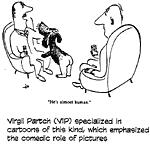 e
caption comic. At a restaurant, a woman is shown with a fork-full of
spaghetti on her head as she asks her male companion across the table,
"How do you like me as a blonde?" In a hotel lobby, a score
of identical men are milling around and one accosts another, saying,
"Your face is familiar, but I don't recall your name." His
reliance upon his pictures to do more than simply set the scene demonstrated
vividly the narrative value of the visual element of a cartoon. e
caption comic. At a restaurant, a woman is shown with a fork-full of
spaghetti on her head as she asks her male companion across the table,
"How do you like me as a blonde?" In a hotel lobby, a score
of identical men are milling around and one accosts another, saying,
"Your face is familiar, but I don't recall your name." His
reliance upon his pictures to do more than simply set the scene demonstrated
vividly the narrative value of the visual element of a cartoon.
As celebrated as his wacky sense of
humor was his zany rendering style that displayed a certain nonchalance
about ordinary anatomy. A frequent objection was made to his unabashed
disregard for the number of fingers that are customarily issued with
each human hand. To this carping criticism, Partch responded patiently:
"I draw a stock hand when it is doing something, such as pointing,
but when the hand is hanging by some guy's side, those old fingers go
in by the dozens. And why not? At Disney, I spent four years drawing
three fingers and a thumb. I'm just making up for that anatomical crime"
("Partch"). When the magazine market began drying up in the
late 1950s, Partch turned to newspaper syndication with Big George, a panel cartoon (1960-1989).
With the virtual collapse of the great
general interest weekly magazines in the sixties, an enormous market
for magazine gag cartoons evaporated. Or, rather, dissipated into scores
of special interest magazines. There, the gag cartoon continues to flourish,
a verbal-visual blend combining brevity and clarity in order to precipitate
an abrupt arrival of complete comprehension—and a laugh. A vivid demonstration
of the mutual importance of words and pictures in the art form, the
modern gag cartoon is the haiku of cartooning, and no definition of
the medium can be complete without embracing it.
Almost all the foregoing appeared in a
collection of essays, The
Language of Comics (University
Press of Mississippi, 2001), edited
by Robin Varnum and Christina T. Gibbons.
Return
to Harv's Hindsights
|